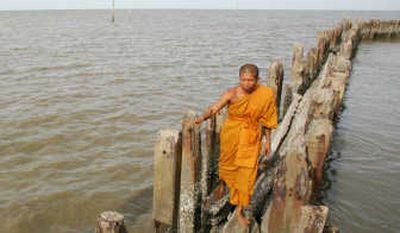Thailand’s capital faces future submersion

KHUN SAMUT CHIN, Thailand – At Bangkok’s watery gates, Buddhist monks cling to a shrinking spit of land around their temple as they wage war against the relentlessly rising sea.
During the monsoons at high tide, waves hurdle the breakwater of concrete pillars and the inner rock wall around the temple on a promontory in the Gulf of Thailand. Jutting above the water line just ahead are remnants of a village that has already slipped beneath the sea.
Experts say these waters, aided by sinking land, threaten to submerge Thailand’s sprawling capital of more than 10 million people within this century. Bangkok is one of 13 of the world’s largest 20 cities at risk of being swamped as sea levels rise in coming decades, according to warnings at the recent Intergovernmental Panel on Climate Change held here.
“This is what the future will look like in many places around the world,” says Lisa Schipper, an American researcher on global warming, while visiting the temple. “Here is a living study in environmental change.”
The loss of Bangkok would destroy the country’s economic engine and a major hub for regional tourism.
“If the heart of Thailand is under water everything will stop,” says Smith Dharmasaroja, chair of the government’s Committee of National Disaster Warning Administration. “We don’t have time to move our capital in the next 15-20 years. We have to protect our heart now, and it’s almost too late.”
The arithmetic gives Bangkok little cause for optimism.
The still expanding megalopolis rests about 3 1/2 to 5 feet above the nearby gulf, although some areas already lie below sea level. The gulf’s waters have been rising by about a tenth of an inch a year, about the same as the world average, says Anond Snidvongs, a leading scientist in the field.
But the city, built on clay rather than bedrock, has also been sinking at a far faster pace of up to 4 inches annually as its teeming population and factories pump some 2.5 million cubic tons of cheaply priced water, legally and illegally, out of its aquifers. This compacts the layers of clay and causes the land to sink.
Once known as the “Venice of the East,” Bangkok was founded 225 years ago on a swampy floodplain along the Chao Phraya River. But beginning in the 1950s, on the advice of international development agencies, most of the canals were filled in to make roads and combat malaria. This fractured the natural drainage system that had helped control Bangkok’s annual monsoon season flooding.
“It’s the only city in the world where a car has collided with a boat,” says Smith, recalling a deluge where residents commuted by rickety boats down roads flanked by high-rises.
He urges that work start now on a dike system of more than 60 miles – walls about 16 feet high, punctured by water gates and with roads on top, not unlike the dikes long used in low-lying Netherlands to hold back the sea.
As authorities ponder, communities like Khun Samut Chin, 12 miles from downtown Bangkok, are taking action.
The five monks at the temple and surrounding villagers are building the barriers from donations and planting mangrove trees to halt shoreline erosion.
The odds are against them. About half a mile of shoreline has already been lost over the past three decades, in large part due to the destruction of once vast mangrove forests. The abbot, Somnuk Attipanyo, says about a third of the village”s original population was forced to move.
The monastery grounds are less than a tenth of their original size, and the waterlogged temple is regularly lashed by waves that have forced the monks to raise its original floor by more than three feet. Among those attending morning prayers, 45-year-old shrimp farmer Rakiet Phinlaphak looks toward the watery horizon from the promontory and says, “I have seen the sea rising higher since I was a child.”